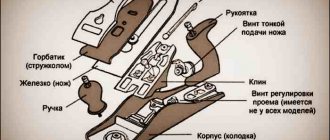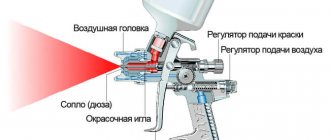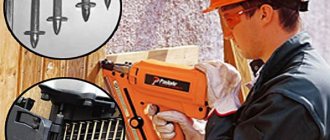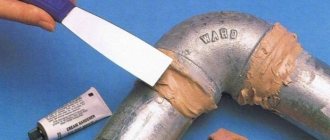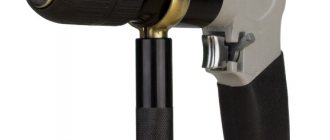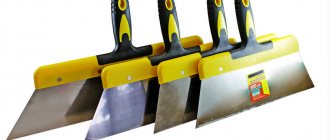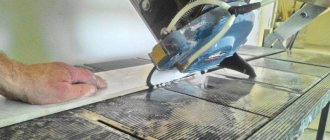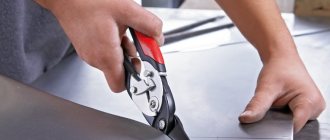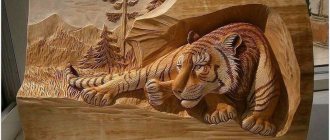What is a petal circle for?
The flap disc wheel is the most common surface finishing tool. In its structure, it is similar to a regular grinding wheel, the main difference is the location of the working segments in the form of petals along the edge. They provide grinding and other processing of flat and concave surfaces. Flap wheels are suitable for working with the following materials:
- metal;
- tree;
- plastic, etc.
Emery cloth on the “petals” acts as an abrasive for cleaning seams or edges, removing rust, scale and burrs, and preparing the surface for painting. KLTs are designed for installation on various power tools and stationary machines.
The flap wheel can be used productively for a long period, since the base of the working segment wears away at the same time as the coating, and a new edge with sharp grain becomes available. The abrasive blades wear evenly, which makes it possible to use the wheel until it is completely worn out.
End flap discs provide the following benefits when working with them:
- constant rotation speed;
- work without noise;
- no vibration;
- the ability to process surfaces of complex shapes;
- high quality of stripping;
- long service life.
Such effective qualities have made KLT the most popular tool in mechanical engineering, metalworking, when performing repairs and other work.
Types of petal circles and scope of application
The flap end disc is the most common type of this grinding tool. It is widely used both at home and in the metalworking industry.
There are two main types of petal end circles:
- Flat. This shape is ideal for abrasive processing of flat surfaces. The large contact area ensures high processing accuracy, reducing the likelihood of gouges. This property is also a disadvantage, reducing the pressure of the sanding elements on the plane.
- Conical. The universal shape allows you to process various curved and curved surfaces. Compared to flat wheels, conical wheels have a smaller contact patch, which makes it possible to work on metal and other materials with a dense structure. In industry, they are used as a cleaning tool for finishing welds, removing beads after laser cutting and burrs that form when cutting metal.
In cone wheels, the abrasive blades have an inclination of 10–15%. This is very convenient during operation, since it is this angle that we try to maintain when performing grinding work, for fear of damaging the surface with the spindle.
End discs of non-standard shape are used much less frequently:
- With slots. This shape allows you to visually control the processing process, adjusting the pressure on the surface if necessary.
- With curved petals. Designed for processing corners. The contact part is the end of the circle.
- Combined. Consumable material for processing stainless steel and other materials requiring delicate handling. In them, sandpaper petals alternate with segments of non-woven abrasive material.
Batch and folded flap wheels consist of many individual abrasive segments that are attached to a metal base. This tool is designed for installation on stationary grinding equipment with a speed control function.
For drills, there are special flap wheels with a mandrel that is installed in the tool socket. A wide selection of standard sizes and abrasive materials used allows the use of wheels with a mandrel for grinding internal and external surfaces made of various materials:
- from ordinary and alloy steel;
- non-ferrous metals;
- wood;
- plastic;
- marble;
- glass
Types and types of petal circles
There are many types of petal circles. For example, depending on the chosen tool, they are intended for:
- electric drill;
- angle grinder (angle grinder);
- production machines.
When choosing a petal disk, you should take into account the features of the upcoming work, based on this, select the desired size and grain size. Abrasive wheels with petals are divided into the following types:
- CL - petal circle with a simple hub;
- KLO (with mandrel);
- KLV (with ventilation);
- KLT (end);
- KLP (batch);
- KLS (folded);
- CLR (radial);
- non-standard and combined circles.
The principle of operation for all types of wheels is the same - grinding the top layer of the surface using abrasive sandpaper glued to the base.
Recommendations for using petal circles
To choose the right flap disk, it is enough to determine the type of material being processed, the work to be performed, as well as the availability of tools. Modern manufacturers offer several modifications of circles:
- KLT-1, which is suitable only for surface grinding;
- KLT-2, suitable for treating hard-to-reach places;
- KLT-3. It is an improved type of the KLT-1 model. Has auxiliary petals, which can significantly increase work productivity;
- KLT-4, with increased flexibility and the ability to process contour surfaces and parts of complex shapes;
- KLT-5, designed for flat grinding of various surfaces. With appropriate pressure, it allows you to perform both coarse and fine grinding of parts, as well as polishing them.
Having chosen the appropriate type of flap end circle, you can begin the corresponding work, without forgetting the need to comply with safety regulations.
Source: www.zavodkorund.ru
Grain size of flap end wheels
KLTs have different abrasive grain sizes. The grain size of the wheel depends on the work for which it is intended. The principle is simple - the rougher the processing, the larger the grain. The marking of Russian-made products differs from foreign ones. Foreign producers assign a large number to small grains (the smallest grain on the foreign production circle is designated 120). Domestic instruments are marked as follows - the higher the number, the larger the grain.
KLTs with grits P40, 60, 80 and 120 are mainly in demand. Wheels with smaller grits are rare. In their manufacture, aluminum oxide is used, which does not have the necessary strength, so the effectiveness of such wheels is low. These parameters are suitable for grinder wheels. For drills, select grain values of 16 (fine), 25 (medium) or 40 (coarse).
Diameter and shape
Currently, consumers are offered the following KLT diameters intended for angle grinders:
- 115 mm (the smallest size, suitable for an angle grinder, convenient for working in confined spaces);
- 125 mm (the most popular size, has high power and compact dimensions);
- 150 mm (not popular due to the small number of suitable angle grinders);
- 180 mm (maximum size, high power and performance).
Flap discs for drills can have a diameter of 60 and 80 mm. When processing wood on machines, wheel models with large diameters (from 150 to 300 mm) are used.
Face grinding wheels are available in conical and flat shapes. The flat shape gives more points of contact with the surface being processed, so it is suitable for flat parts and seams on straight surfaces. The universal conical shape allows you to successfully clean large seams from welding; such circles are often used in the production of various containers. By design, the conical KLT has an inclination angle of 10-15 degrees, so it makes it possible to process curved and curved surfaces without additional effort.
Circle design and shape
Previously, all foam polishing pads had a flat face. This makes sense because the entire surface area in contact with the paint is used. However, now you can find different designs of polishing wheels on sale. There are foam circles with wavy shapes, hexagonal patterns and others. Different designs have been developed to keep the paint surface cooler and allow the polish to release slowly into the paint. But while these design changes offer some performance improvements, they've also made the market more complex and harder to figure out what you need. In addition to the design, there are some differences in the shape of the circles. Even if you don't delve into the wide variety of shapes and designs and use polishing pads with a classic flat surface, you can achieve excellent results.
Polishing pads are attached to machines with a so-called support pad. This is a disk with a threaded bushing on one side (for screwing into the spindle of the machine) and Velcro on the other side (for attaching circles). The size of the circle depends on the size of your support pad.
Polishing wheel thickness
Thinner circles have the following features:
- Increased polishing power.
- Less pressure required when polishing.
- The risk of the supporting substrate touching the paintwork increases.
Thicker circles have the following features:
- Reduced polishing power.
- More pressure is required to compress the foam if necessary.
- Reduced risk of the supporting substrate touching the paintwork.
Some detailers like the feel of using thinner circles because of the literal and figurative feeling of being close to the paint. This can offer greater control over work. Productivity and work speed are generally better with thinner polishing pads.
How does the thickness of the polishing wheel affect the polishing of an orbital polisher?
Double action (orbital) polishers combine a rotating motion with a small orbital action. In order for these machines to effectively correct paint, they must be able to transmit both movements through the circle, onto the paint surface.
As the double action machine moves the support pad, some of the movement is absorbed by the wheel material. This can greatly weaken orbital motion. For the most effective polishing, it is important to transfer as much of this action to the paint as possible. The size of the buffing wheel directly affects how much traffic it absorbs. The thicker the wheel, the more polishing action is absorbed. A thinner wheel transmits movement more effectively and thus increases polishing power. A larger diameter polishing pad, due to the increased surface area, will also absorb more orbital motion, although the effect is not as pronounced as with increasing thickness.
Materials used in manufacturing
The end flap wheels consist of an elastic base, an adhesive bond and an abrasive material.
The following materials are most often used for the base:
- paper;
- textile;
- fiber;
- different combinations of these materials.
Since the main workload falls on abrasive grains, durable materials of natural or synthetic origin are used here:
- alumina;
- silicon compounds (dioxide or carbide);
- diamonds;
- boron nitride;
- zirconium;
- electrocorundum, etc.
Currently on sale you can most often find disc-shaped circles made from:
- aluminum oxide (relates to inexpensive abrasives);
- aluminum zirconate (features an affordable price with high performance and durability);
- ceramic grain (the most expensive and high-quality material for CLT;
- mixtures of ceramic and zirconium grains (zirco-ceramics).
Before purchasing a product, you can visually determine the material from which the petal disc is made, since there are color differences. Brown color indicates that aluminum oxide is used in CLT. The blue or green tint guarantees the strength characteristic of aluminum zirconate. The red color indicates the presence of highly resistant ceramic grains in the abrasive fabric.
Production materials
The end flap disk consists of an elastic structure base, an adhesive bond and an abrasive. The basis can be:
- Paper.
- Fabric.
- Fiber.
- From several materials.
The working part, consisting of abrasive grains, can have an artificial or natural composition:
- Alumina.
- Silicon carbide.
- Diamonds.
- Boron nitrite.
- Zirconium.
- Electrocorundum.
Aluminum oxide abrasive is considered the most inexpensive. Aluminum zirconate grinding material is considered the most inexpensive of the productive models. For higher quality and more expensive models, ceramic grain is used.
The material used to make the granular layer can be visually determined by the color of the abrasive disc. Aluminum oxide models are brown in color. The blue and green circles are made of aluminum zirconate. Increased durability of red discs based on ceramics.
